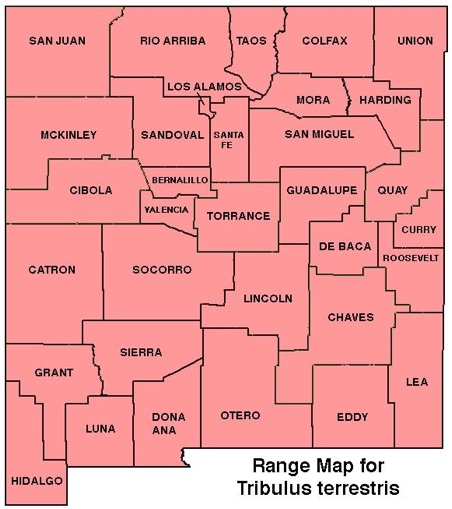WILDFLOWERS OF NEW MEXICO

Sprawling, trailing stems to 3-feet long form loose mats up to several feet wide. The small yellow flowers develop into brutal burs that are severely painful to bare feet and can puncture bicycle tires. This introduced, invasive plant common to disturbed areas contains a saponin that is toxic to livestock.
FLOWERS: May–November. Single flowers, 1/4–3/8-inch wide (6–10 mm) on short stems from the axil of the smaller of the paired leaves; 5 petals, lemon-yellow, rounded to squared with notched to entire tips; 10 stamens. The seed bundle separates into 5 nutlets with stout, thorny spines.
LEAVES: Opposite, compound leaves are 3/8–1 3/4-inches long (10–45 mm) with one of each pair smaller. Each leaf has 3–6 pairs of elliptic leaflets tapering to a point; surfaces and margins have scattered hairs.
HABITAT: Sandy, gravelly soils, yards, street medians, vacant lots, disturbed areas; shortgrass prairies, desert grasslands and scrub, pinyon-juniper.
ELEVATION: 3,200–7,800 feet.
RANGE: Widespread west of the Mississippi River.
SIMILAR SPECIES: Warty Caltrop, Kallstroemia parviflora, statewide, and several look-alike caltrops, have an orange flower with a reddish center, a seed bundle with a tiny beak, and seeds without thorns.
NM COUNTIES: Statewide invasive in yards, cultivated, disturbed areas.









GOATHEAD, PUNCTURE VINE
TRIBULUS TERRESTRIS
Creosote Bush Family, Zygophyllaceae
Annual herb; introduced, naturalized


















THE CONTENTS OF THIS WEBSITE ARE COPYRIGHTED AND CANNOT BE USED
WITHOUT PERMISSION OF GEORGE OXFORD MILLER








Compound leaves have 3–6 pairs of leaflets. One of the paired compound leaves is smaller.









Flowers produce wicked burs that can puncture bicycle tires.

















EMAIL ME







